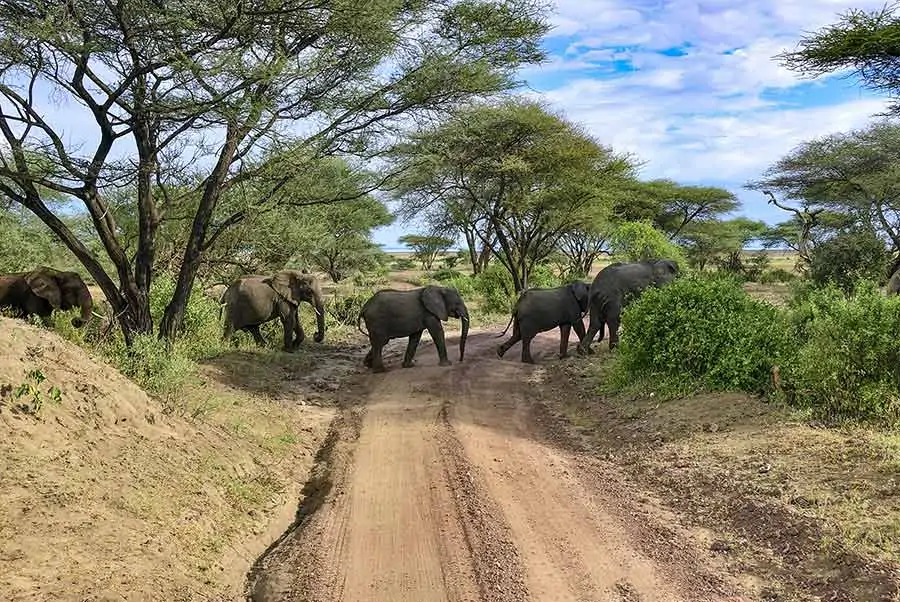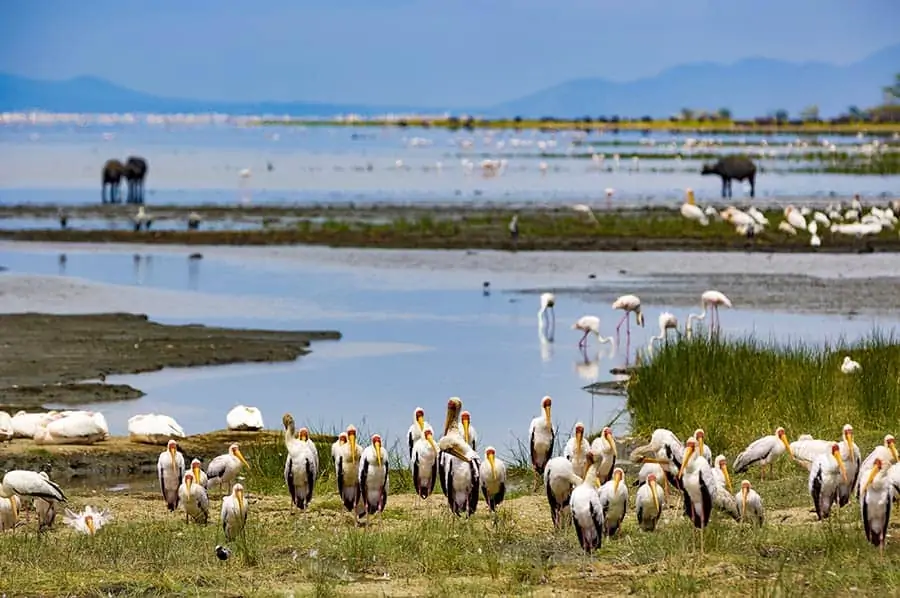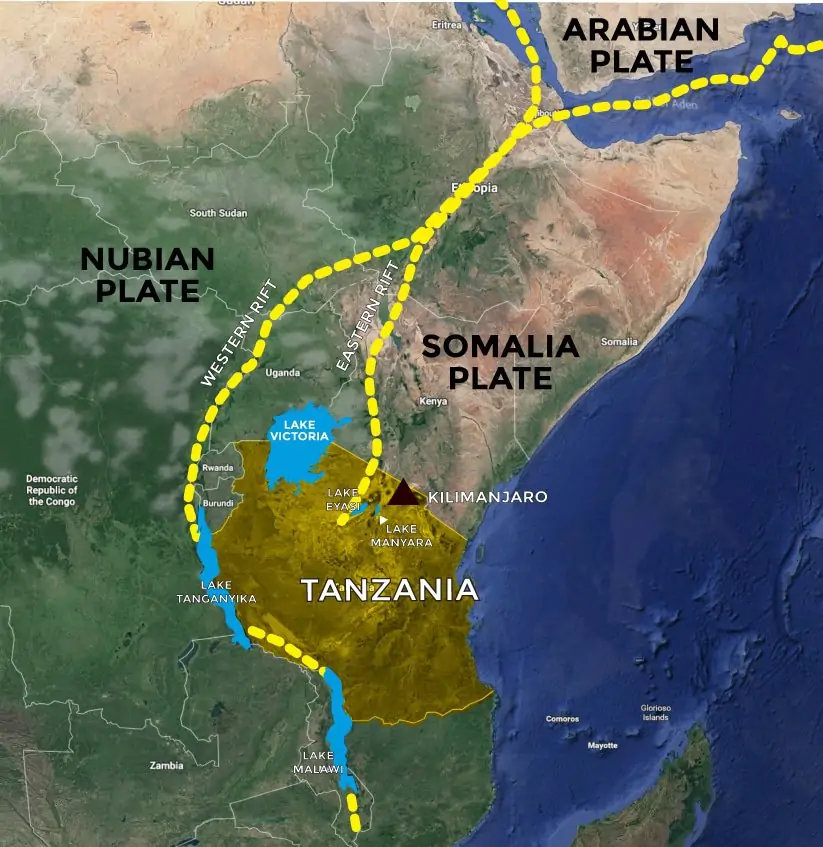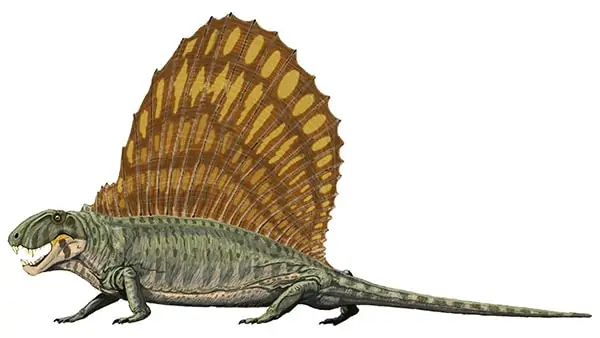Paleoanthropologists have found hundreds of fossilized bones and stone tools in the area dating back millions of years, leading them to conclude that humans evolved in Africa.
Why Should You Go to Lake Manyara National Park?
Lake Manyara National Park is a small park located right at the end of the Eastern branch of Great Rift Valley. It is known as the Gregory Rift. You can see more about the Valley by clicking on the map below.

Lake Manyara National Park delivered its name from a plant called Euphorbia Tirucalli, known as Emanyara in Maasai language. The Maasai use this hedge-like plant protect their bomas. The term then expanded to the entire region, not just the lake.
The Park was named a National park in 1960 and was declared as Man and Biosphere Reserve in 1981. The park has an area of 402 sq miles of which 163 sq miles is covered by the lake and 240 sq miles is dry land.
The rainfall pattern of the park is bi-modal with short rains starting from November to December and long rains from February to Ma. The dry season is from late June to October. The annual mean temperature is 79.7° F. The average temperature 52.4° F. and relative humidity ranges from 45%-85%.
The park can be accessed throughout the year. However, June through October is the best time for large mammals. November through July is an ideal time for bird watching.
The Great Rift Valley
The Great Rift Valley is a name given to the continuous geographic trench, approximately 3,700 miles long. The trench begins in Lebanon’s Beqaa Valley in Asia and continues to the country of Mozambique in Southeastern Africa on its western fork and to Tanzania on its eastern fork.
Today, the Great Rift Valley is usually referring to the valley of the East African Rift. It is also known as the Gregory Rift since it was discovered by Scottish explorer John Walter Gregory. The divergent plate boundary extends from the Afar Triple Junction southward across eastern Africa. It is in the process of splitting the African Plate into two new separate plates. Geologists refer to these new plates as the Nubian Plate and the Somali Plate.
Furthermore, the Great Rift Valley divides the country of Kenya almost straight down the length of the nation. It basically separates the east from the west. This region is characterized by inhospitable desert, fertile farmland, flat arid plains, steep cliffs and at least one very usual, scaly, fin-backed monster.
Rift Valley Monster Fact or Fiction?
Reports of Rift Valley Monster were once believed to be a dinosaur or dinosaurs that had survived extinction. Since parts of the Valley is made deep canyons. It was difficult for explorers to penetrate the forbidding depths to verify the creature’s existence. However, eyewitnesses made mention of the beast throughout the ages. This led cryptozoologists to speculated that what they actually saw was the Dimetrodon Grandis.
The Dimetrodon Grandis was not a dinosaur. It was a mammal-like reptile. It was notable for the large, sail-like fin which adorns its spine. This specimen could be from the family known as Sphenacodonts.
Today, researchers are skeptical that the creature ever existed. No one has made mention of seeing one in many years, if at all. Surely one of the thousands of Kenyan tourists would have captured footage on their GoPro and posted it to Instagram by now.
Gregory Rift in East Africa
The Gregory Rift is the eastern branch of the East African Rift fracture system. A thermal plume created the rift which now separates the Somali plate from the Nubian plate. Although the term is sometimes used in the narrow sense of the Kenyan Rift, the larger definition of the Gregory Rift is a cluster of rifts that extend from the Gulf of Aden, near Saudi Arabian south through Ethiopia and Kenya. It ends in the country of Tanzania, near Lake Manyara National Park. Ancient fossils of early hominins, the ancestors of humans, have been found in the southern part of the Gregory Rift.
 Olduvai Gorge
Olduvai Gorge
The Olduvai Gorge is a misspelling of Oldupai, a Maasai word for a wild sisal plant that grows in the area. The Gorge falls within the Eastern fork of the Great Rift Valley. Located in the country of Tanzania, it is one of the most important paleoanthropological sites in the world. It has proven invaluable in furthering our understanding of early human evolution.
The Olduvai Gorge is a steep-sided ravine. It is approximately 30 miles long and is located in the eastern Serengeti Plains.
In 1937, the combined British and Kenyan paleoanthropologist-archeologist team of Mary and Louis Leakey established and developed the excavation and research programs at Olduvai Gorge. They were able to achieve great advances in human knowledge. They became world-renowned status based on their discoveries. Among their most notable finds were several extinct vertebrates. This included the 25-million-year-old Pronconsul primate, one of the first and few fossil ape skulls discovered.
Homo habilis, probably the first early human species, occupied Olduvai Gorge. They were followed by Paranthropus Boisei, then Homo Erectus and finally Homo sapiens.
 The dig site is significant in showing the increasing developmental and social complexities in the earliest humans, or hominins. Stone tools reveal their development. Prior to tools, there was evidence of scavenging and hunting. This is highlighted by the presence of gnaw marks that predate cut marks. The ratio of meat versus plant material in the early hominin diet was also significant. All these factors indicate an increase in cognitive capacities. This marks the beginning of the period of hominids transitioning to hominin—that is, to human—form, and behavior.
The dig site is significant in showing the increasing developmental and social complexities in the earliest humans, or hominins. Stone tools reveal their development. Prior to tools, there was evidence of scavenging and hunting. This is highlighted by the presence of gnaw marks that predate cut marks. The ratio of meat versus plant material in the early hominin diet was also significant. All these factors indicate an increase in cognitive capacities. This marks the beginning of the period of hominids transitioning to hominin—that is, to human—form, and behavior.
Lake Manyara
 American author Ernest Hemmingway once declared the region encompassing Lake Manyara National Park to be, “…the loveliest I had seen in Africa.” Lake Manyara is located between Tarangire National Park and the spectacular Ngorongoro Crater in northern Tanzania. it is about an hour and a half drive from the city of Arusha. The Lake Manyara region is teeming with exotic flora and fauna up against an amazing backdrop.
American author Ernest Hemmingway once declared the region encompassing Lake Manyara National Park to be, “…the loveliest I had seen in Africa.” Lake Manyara is located between Tarangire National Park and the spectacular Ngorongoro Crater in northern Tanzania. it is about an hour and a half drive from the city of Arusha. The Lake Manyara region is teeming with exotic flora and fauna up against an amazing backdrop.
One of the primary draws of the park is the enormous diversity of wildlife it contains. During the wet season, you can expect to see flocks of flamingos numbering in the thousands on the lakeshore. The Dik Dik is a very tiny herbivore that looks like an antelope. Foliage and berries are its main source of food. Local predators such as Tanzanian cheetahs, African leopards, and Maasai lions hunt them because of their small size. A hippo pond in the area allows tourists to get a good look at one of Africa’s most iconic animals. The African bush elephant roams the park and visitors can drive up close for breathtaking photos.
The Park Features
Lake Manyara National Park is a good way to immerse yourself in the safari parks without the long drive to the Serengeti. The eastern gate, for example, will have you driving past countless baboons and blue monkeys through a jungle-forest. You can marvel at the beautiful mahogany trees as you go. The unique combination of plants and animals in the forest alone is truly stunning—and practically within arm’s reach.
After you exit the forest, you’ll drive through the floodplains. Here you’ll see giraffes, buffalo, flamingos, and zebra roaming wild. In addition to the animals, you’ll see the lake itself, a glistening expanse of blue reaching out to the horizon. Wildlife of all shapes and sizes swim in the lake. Across the lake, you’ll see the edge of the volcanic Maasai Steppes stretching to the sky.
After spending time at the lake, you’ll enter the acacia woodland. This is the favorite spot of tourists. It is here that you will see elephants, blue monkeys, baboons, mongooses, and the elusive tree-climbing lions. Throughout your visit, you will be exposed to up to 400 different kinds of birdlife, and while you’re not likely to see all of them, you’ll almost certainly see several dozen on any given day.
If you are visiting the park on your own. There are many activities available—including, mountain biking, rappelling, canoeing, game drives, and picnics. You can easily stretch your visit to more than just a jeep tour by filling the time with any of the previously mentioned activities.
Ultimately, Lake Manyara National Park is a great place for people who want to see several sides of Africa all at once. One of the great things about the park is that, despite being so close to Serengeti National Park, it doesn’t get the same crowds, so your experience is likely to be much more intimate and personal without having to sacrifice the quality of the scenery or the diversity of the wildlife. If you want to have a relaxing safari surrounded by some of the most stunning views Africa has to offer, Lake Manyara National Park is definitely worth a visit.
Since it is a small safari park, we have combined it with several other safaris beginning with the 2-day standard safari. Add a safari after your climb for a perfect way to relax and experience one of the best safari parks in Africa.
2-Day Safaris
On the 2-day safari, you will also visit the magnificent Ngorongoro Crater. It is like a mini Serengeti. It is 11 miles across and 2000 ft deep and is home to many animals such as the cape buffalo, black rhino, hippopotamus, wildebeest, zebra, waterbucks, gazelles, ostrich and of course lions. The flamingos blanket the lake in a sea of pink. Read more here: https://peakplanet.com/ngorongoro-crater/
3-Day Safaris
On the 3-day safari, in addition to the Ngorongoro Crater, you’ll also visit the Tarangire National Park. Massive herds of elephants call the park home. You can read more about the park and it’s inhabitants here: https://peakplanet.com/tarangire-national-park/
5 and 6 Day Safaris
On the 5-day safari and 6-day safari. You also journey to the best safari park in the world—the Serengeti. Tanzania’s oldest and most popular national park, also a World Heritage Site and recently proclaimed a 7th Natural Wonder of Africa. The Serengeti is famed for its annual Great Migration. This migration averages six million wildebeest, more than 200,000 zebras and 300,000 Thomson’s gazelle journey from the Southern Serengeti Plains of Tanzania to the Maasai Mara Reserve of Kenya. Yet even when the migration is quiet, the Serengeti offers arguably the most amazing game-viewing in Africa.
The Serengeti teams with wildlife such as large herds of buffalo, elephant, and giraffe. Thousands of eland, topi, kongoni, impala, and Grant’s gazelle also make up the herd.
The park covers nearly 5,700 square miles. Animals roam freely within its massive borders. A unique combination of diverse habitats enables it to support more than 30 species of large herbivores and nearly 500 species of birds.
The wind, rain, and sun have sculpted the originally formed volcanic landscape. As a result, it now varies from open grass plains in the south, savannas with scattered Acacia trees in the center, hilly, wooded grassland in the north, to extensive woodland and black clay plains to the west. Scattered throughout its landscape is small rivers, lakes, and swamps. It is near these small bodies of water that most of the action occurs. You can watch as lioness train their cubs to hunt or stalk an unsuspecting impala. Or perhaps you may witness a crocodile snatch its prey from the banks of a waterhole. The Serengeti is a must-see safari. You will need to book at least a 3-day fly-in or 4-day driving safari to experience everything this park has to offer.
Finally, to go to Africa and not do a safari would be a shame. Tanzania is home to the best safari parks in the world. You can’t do a safari without visiting the Serengeti and you may as well stop by the little-hidden gem of a park known as Lake Manyara along the way.




